|
What follows under this section, is
an introduction to matrix algebra which is essential in order to
understand the discussion of more advanced econometrics and statistics.
Most properties are only defined or described
without giving examples, exercises, or rigorous proofs. In any case
remember, mathematics is pure fun!
We write a column and row vector
as follows
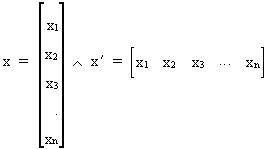
(I.IV-1)
where the prime (') is an indication of transposition.
The length of a vector is defined as

(I.IV-2)
Note the following, obvious relationships

(I.IV-3)
We write a n*m matrix as follows

(I.IV-4)
Addition
of matrices can be defined as

(I.IV-5)
whereas
multiplication can be
written as
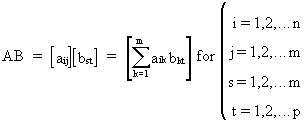
(I.IV-6)
Transposition
of matrices has two simple properties

(I.IV-7)
The multiplication
of two diagonal matrices results in a diagonal matrix

(I.IV-8)
where a 'diagonal
matrix' can be defined as

(I.IV-9)
A special diagonal matrix
is a matrix where all diagonal elements are equal to one (identity
matrix denoted I).
Therefore, it is obvious that

(I.IV-10)
A matrix with only zero
elements is neutral in addition

(I.IV-11)
Vectors are told to be linearly
independent if

(I.IV-12)
Now we are able to define the rank
of a matrix as the number of linearly independent rows or columns.
Also note that all zero matrices have rank = 0. The rank of a (m*n)
matrix is equal to the rank of the largest sub matrix with a
determinant different from zero where the determinant
of a matrix is defined by

Note that a determinant
of a two by two matrix can be found by

(I.IV-13)
It is also quite obvious that the rank
of a product of two matrices is less or equal to the rank of
either the one or the other matrix.
Transposition
does not alter the rank of a matrix.
If a square matrix has a full rank
(rank equal to the number of rows or columns) we call this matrix not
singular.
Furthermore, if we have a
square non singular matrix then the inverse
of a matrix A can be
defined as

if and only if

(I.IV-14)
The inverse
of an inverse matrix, is equal to the original matrix

(I.IV-15)
and the inverse
of the transposed is the transposition
of the inverse matrix

(I.IV-16)
A diagonal
matrix is non singular if, and only if all diagonal elements are different
from zero. Above this, the inverse of such a matrix can be found by writing a diagonal matrix
where all diagonal elements are replaced by their respective
reciprocals.
The determinant
of a product AB (if AB exists) is equal to the product of the
determinants if both matrices are square

(I.IV-17)
The rank of AB
and the rank of CA are
equal to the rank of A if
B and C are non singular.
If A
and B are of the same order then

(I.IV-18)
If

then M
is said to be idempotent. In our discussions we'll also always assume that these
idempotent matrices are symmetric (which means that the element of
the i-th row and the j-th column is equal to the element of the j-th
row and the i-th column).
An important example of an
idempotent matrix is
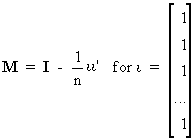
(I.IV-19)
which can be shown quite
easily

(I.IV-20)
Idempotent matrices are
very important in order to write variables as deviations
from the mean. For instance, if B
is an observation matrix and M
is the idempotent matrix of (I.IV-20), then we can write

(I.IV-21)
where obviously all columns of B have been written as their deviation from the mean.
Even the sum of the square products B'B
of a square matrix B can
be written as deviations from the mean: (MB)'MB = B'MB
(where M is again
idempotent).
When using two different matrices B
and C it is still
possible to write the deviations from the mean of the sum of square
products (B'C)
as follows: (MB)'MC
= B'MC.
Define the trace of a
square matrix A as

(I.IV-22)
It is obvious that the
following rules hold for the trace of a matrix:
a) tr (k A) = k tr A where k is a
real number
b) tr(A+B) = tr A
+ tr B
c) tr (AB) = tr (BA)
d) tr A
= rank A if A is idempotent
A quadratic
form associated with
a symmetric square matrix A
is defined as the scalar

(I.IV-23)
(A
is considered to be a square symmetric matrix).
A
is called a positive definite
matrix if and only if
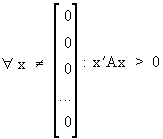
(I.IV-24)
A positive
semi definite matrix is


(I.IV-25)
Obviously a negative
definite and a negative
semi definite matrix can be defined analogously.
An indefinite
matrix however is defined

(I.IV-26)
The matrix A
is positive definite if
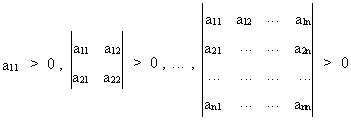
(I.IV-27)
All principal minors and the
determinant of a matrix A
are positive if A is positive definite.
A very important property is that
all positive definite
matrices are non singular!
If A
is positive definite (pos. semi def.) and B
is non singular then B'AB
is also positive definite (pos. semi def.).
If there exists a m*n matrix A
with rank m<n then AA'
is positive definite and A'A
is positive semi definite but never positive definite.
If there exists a m*n matrix A with rank r<m and r<n then AA' and A'A
are both positive semi definite but neither will be positive
definite.
If there exists a square symmetric
and positive definite matrix A
then there always exists a non singular matrix P such that P'P
= A. This is a very important property.
Define an eigenvalue
lambda and an eigenvector
x of the square matrix A
as
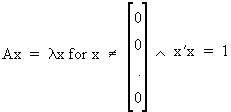
(I.IV-28)
Since the eigenvector x is different from the zero vector the following is valid
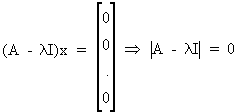
(I.IV-29)
Note that eigenvectors are also
called the "latent"
roots.
It is very interesting to
note that

(I.IV-30)
If we define the complex
(imaginary) number i such that

(I.IV-31)
then the latent
root (x + iy) of a symmetric square
matrix A is always real!
Proof:

(I.IV-32)

(I.IV-33)

(I.IV-34)

(I.IV-35)
Since, due to the symmetry
of A,

(I.IV-36)
it follows from (I.IV-35)
and (I.IV-36) that

(I.IV-37)
If a square matrix A
is symmetric then the eigenvectors
corresponding to the different eigenvalues are all orthogonal (independent from each other). Suppose we would have two
latent roots with corresponding eigenvectors x
and y then we can write

(I.IV-38)

(I.IV-39)

(I.IV-40)

(I.IV-41)
and since

(I.IV-42)
which
implies that the eigenvectors
corresponding to different eigenvalues are independent.
If x
is a characteristic (eigen)vector of the square matrix A
with root lambda then

(I.IV-43)
If x
is an eigenvector of A
then -x is also an
eigenvector of this matrix. Note the following (almost trivial)
relationship

(I.IV-44)
If A
is a non singular square matrix then the roots
of the inverse of A are equal to the reciprocal values of the roots of A
but the eigenvectors are the same. This can be seen quite easily by

(I.IV-45)
and therefore

(I.IV-46)
The latent
roots of a positive definite (pos. semi def.) matrix are positive (non
negative). Of course, analogously one can formulate a similar
property for negative (semi) definite matrices.
The number of roots of a
symmetric matrix A that
are different from zero is equal to the rank of A.
If all roots of a symmetric matrix A
are positive (non negative) then all the diagonal
elements of A are
positive (non negative).
The non zero roots of AA'
and A'A are always the
same.
If x1,
x2 are eigenvectors (corresponding to different roots) of
AA' are pair wise independent with unit length, then the vectors A'x1,
A'x2 are also orthogonal but without unit length (except
if all l values are equal to one).
Define an orthogonal
matrix A as

(I.IV-47)
which
also implies that all rows and columns have unit length.
If A
is a square matrix with different
roots and corresponding eigenvectors

(I.IV-48)
then it follows by
definition (I.IV-28) that

(I.IV-49)
and

(I.IV-50)
Now we put the orthogonal
vectors gi into a n*n matrix G like
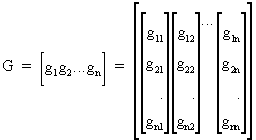
(I.IV-51)
and therefore it follows
that G'G = I (and thus G
is orthogonal). Furthermore, by pre-multiplying G
by matrix A, we obtain

(I.IV-52)
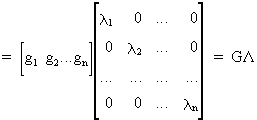
(I.IV-53)
Now we can easily find that

(I.IV-54)
and

(I.IV-55)
If a matrix A
has rank r then there are only r
non zero eigenvectors (with rank 1) and n-r zero eigenvectors
(abstraction has been made for the sign).

The determinant
of an orthogonal matrix is equal to 1 or -1.
The real
roots of an orthogonal matrix G are
always equal to 1 or -1 which can be seen quite easily

(I.IV-56)

(I.IV-57)

(I.IV-58)

(I.IV-59)

(I.IV-60)
If A
is a positive semi definite matrix of rank r then

(I.IV-61)
therefore P'
is equal to

(I.IV-62)
All idempotent
matrices have a root of 0 or 1.
For the square
idempotent matrix M
with rank r the following property is valid

(I.IV-63)
where
D is a diagonal matrix with r diagonal elements equal to 1 (and all other
elements equal to zero).
All idempotent
matrices A are positive semi definite with non negative diagonal elements since

(I.IV-64)
which
is just a sum of squares of the elements of Ax.
If a square idempotent
matrix A is non singular then A must
be equal to the identity matrix I
since

(I.IV-65)
If A
is idempotent and G is
orthogonal then G'AG is
idempotent as well since

(I.IV-66)
If A
is idempotent then I - A
is also idempotent but A(I -
A) = O.
If A
is idempotent and the
element aij = 0 then it follows that the i-th row vector
and the j-th column vector consists of nothing but zero elements.
We define the following derivatives
of matrices (where A is
not necessarily symmetric)

(I.IV-67)

(I.IV-68)

(I.IV-69)

(I.IV-70)

(I.IV-71)

(I.IV-72)

(I.IV-73)

(I.IV-74)

(I.IV-75)

(I.IV-76)

(I.IV-77)

(I.IV-78)
We define the Kronecker
(or Tensor) product as
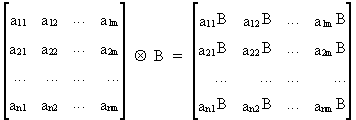
(I.IV-79)
with the following
properties
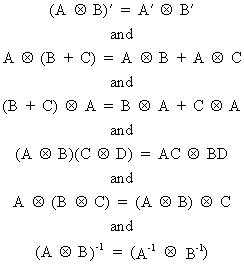
(I.IV-80)
and last but not least

(I.IV-81)
where
A is a n*n, and B is a m*m matrix.
Sometimes it is useful to
write matrix expressions in partitioned form. Addition and multiplication rules with respect to
partitioned matrices are quite simple
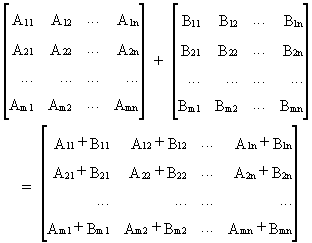
(I.IV-82)
and
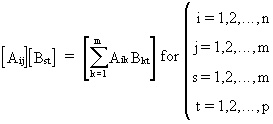
(I.IV-83)
which
is a generalization of (I.IV-6) and for which Aik has the same number of columns as the number of rows
of Bkt.
It is easily verified that
the inverse of a symmetric
partitioned matrix can be written as
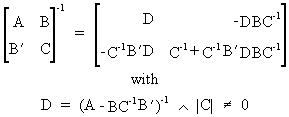
(I.IV-84)
or equivalently
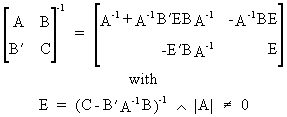
(I.IV-85)
Sometimes a matrix is written in
upper or lower triangular
form. An upper triangular matrix A(m*n)
is a matrix were all elements (for m larger than n) are zero.
Analogously a lower triangular matrix can be defined.
Imagine an upper triangular
matrix T(3*3) with units in the diagonal, and a diagonal matrix D(3*3)

(I.IV-86)
then

(I.IV-87)
It can be shown that any matrix
square symmetric A can be
written as T'DT according
to Choleski's decomp.
theorem. It is also interesting to see that the A
matrix can be transformed to become a diagonal matrix:
D
= (T')-1AT.
| 
